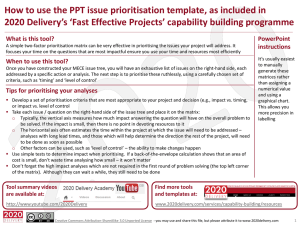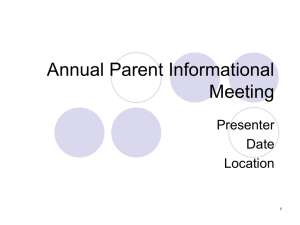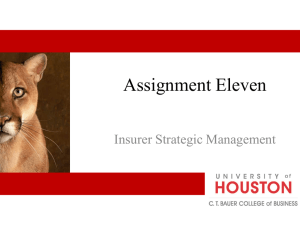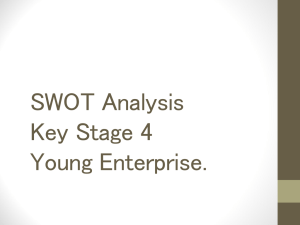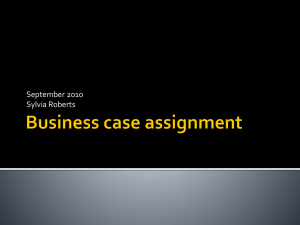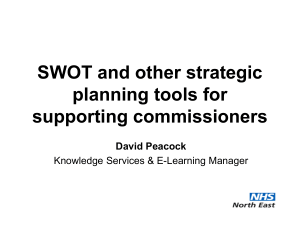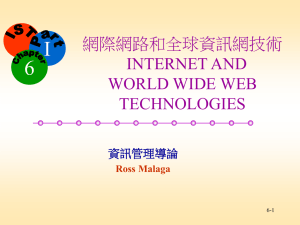SWOT Analysis & Perceptions - Dr. Elsa
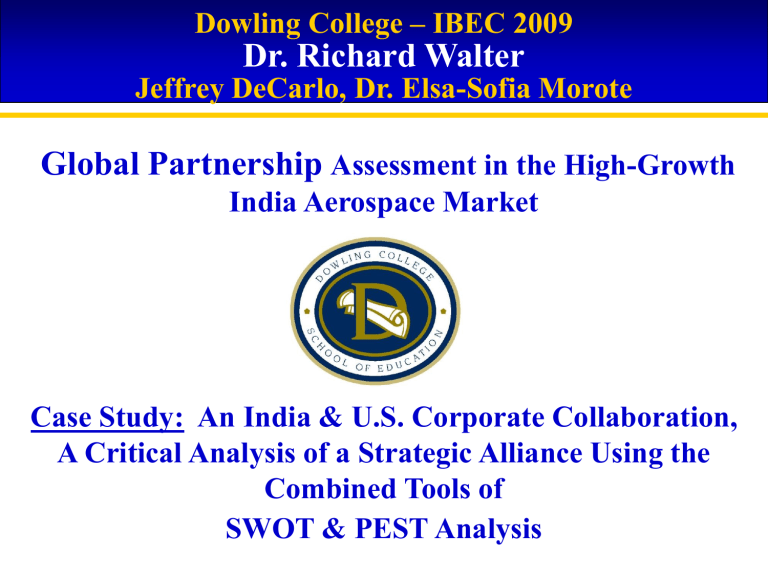
Dowling College – IBEC 2009
Dr. Richard Walter
Jeffrey DeCarlo, Dr. Elsa-Sofia Morote
Global Partnership Assessment in the High-Growth
India Aerospace Market
Case Study: An India & U.S. Corporate Collaboration,
A Critical Analysis of a Strategic Alliance Using the
Combined Tools of
SWOT & PEST Analysis
Overview
Case Study – Purpose
SWOT & PEST
• Roots of Strategic Business Analysis
• Evolution and Practical Application
Real World vs. Research
Purpose of Case Study
Analyze the perceived benefits of combining two
methodologies to analyze the viability of a collaborative, international business relationship
:
SWOT (Strengths, Weaknesses, Opportunities and Threats)
&
PEST (Political, Economic, Social and Technological)
Case Study
Examination of three companies
Two from the U.S., the other from India
Assess the viability of a collaborative, international,
India-focused business construct (consortium).
Roots
SWOT analysis is prevalent in the business world with the linear, straightforward concepts adaptable to a multitude of users and industries
The theoretical underpinnings for SWOT have roots in the
1950s when the ideas of internal and external factors emerged as a qualitative tool for strategic management
(Selznick, 1984)
Albert Humphrey is also credited with being one of the founders of the SWOT technique during research at
Stanford in the 1960s ( Businessballs , n.d.)
SWOT Analysis & Perceptions
Traditional SWOT analysis as a business planning and strategic management tool:
•Sometimes critiqued for being too simplistic
•Reliant on the opinions of only a few (sometimes only one) of the key players of a business
•Subjective due to the qualitative nature of the model
SWOT Analysis & Perceptions
The simplistic characteristics of SWOT model:
•Perceived asset to some and a limitation to others
•Simplistic nature should not be allowed to corrupt the data analysis and the resultant conclusions and recommendations
(Novicevic, Harvey, Autry, & Bond III, 2004)
SWOT Analysis & Perceptions
The simplistic characterization might also be the impression of those with less than a full understanding of the possible ways that the data can be analyzed and interpreted
A New Mexico State University tutorial offers a multi-level perspective of SWOT:
•Beginner level focused on undergraduate students, the
•Intermediate level for MBA students and
•Advanced level for doctoral students.
•Latter examples include sophisticated discussions of non-linear SWOT analysis, chaos theory and complexity patterns ( SWOT Analysis Tool , n.d.)
SWOT Analysis & Perceptions
Multiple perspectives are needed in order to insure the quality of the analysis
A single viewpoint, even from a CEO with a broad perspective, might be improved by the inclusion of opinions from a cross-section of stakeholders ("SWOT Analysis," n.d.)
SWOT Analysis & Perceptions
SWOT Analysis Framework ("SWOT Analysis," n.d.)
Environmental Scan
/
Internal Analysis
\
External Analysis
/ \
Strengths Weaknesses
|
SWOT Matrix
/ \
Opportunities Threats
SWOT Analysis & Perceptions
Variation
SWOT / TOWS Matrix ("SWOT Analysis," n.d.)
Strengths Weaknesses
Opportunities
S-O strategies W-O strategies
S-T strategies W-T strategies
Threats
•S-O strategies pursue opportunities that are a good fit to the company's strengths.
•W-O strategies overcome weaknesses to pursue opportunities.
•S-T strategies identify ways that the firm can use its strengths to reduce its vulnerability to external threats.
•W-T strategies establish a defensive plan to prevent the firm's weaknesses from making it highly susceptible to external threats.
PEST Analysis & Perceptions
“A PEST analysis most commonly measures a market; a
SWOT analysis measures a business unit, a proposition or idea” (Businessballs, n.d.)
A PEST analysis completes the external factors covered by the SWOT organizational analysis of the opportunities and threats (Schildhouse, 2006)
PEST Analysis & Perceptions
The subject case study presents the SWOT analysis prior to the PEST analysis, although some argue that the PEST should be completed first because it can assist in identifying the organizations external SWOT factors (Businessballs, n.d.)
PEST Analysis & Perceptions
Howard Thomas of Warwick Business School is the author of an article that analyzes the environment and competitive dynamics of management education (Thomas, 2007)
• Uses the PEST analysis to examine the external factors that influence the strategic decisions including
“government, competitors, technological and social change and the dynamics of buyer and supplier markets” (Thomas, 2007, p. 10)
• Details the PEST analysis findings environmental factors in terms of “forces and drivers”
PEST Analysis & Perceptions
PEST Analysis Framework ("SWOT Analysis," n.d.)
Environmental Scan
/ \
External Analysis Internal Analysis
/
Macroenvironment
|
P.E.S.T.
\
Microenvironment
Other Theories
Postmodernists – “Strategy as Simulacra”
• Radical Reflexivity – Any well-ordered world view is too simplistic
• Hyperreality where organizational principles are neatly ordered, but with no origins in reality
• First, Second and Third Order
Other Theories
Quantitative SWOT
• Japan Machine Tool Builders Association
• Multiple variable analyses – Weighted averages
• Complex interrelationships clarified and quantified
Other Theories
India “Root Branch” Framework (Karki, 2004)
• This conceptual construct is an innovative, realistic and timely model that focuses on the international growth of the Indian economy
• Rajnish Karki states that Indian corporate strategy should be built around “attaining a consistency among various components of the ‘root business’ and strategic direction, ‘branch’ (2004, p. 1)
Combined Use of SWOT & PEST
The utilization of combined SWOT and PEST analysis methodology is not well documented in the research literature
In fact, although SWOT analysis alone is mentioned quite often, PEST analysis alone is difficult to find in the research literature. Obviously, review of the research literature relating to the combination of the two techniques yields little material
There are a few related articles that mention the use of
SWOT with PEST, although the literature reviewed is not scholarly research (Schildhouse, 2006)
Combined Use of SWOT & PEST
A recent interview with Honeywell’s director of aerospace sourcing, Willis D. Pugh confirmed that their company believes that “SWOT works very well with PEST
•Drills down further to help understand the risk analysis associated with a particular project” when evaluating different regions and different countries
(Schildhouse, 2006, p. 2)
Combined Use of SWOT & PEST
Pugh suggests that the combined use of SWOT and PEST as part of a fully integrated strategic, high level, sophisticated and practical approach
• More thorough than SWOT alone, and helps to evaluate the risk associated with business and projects in various international regions”
(Schildhouse, 2006, p.2)
The subject case uses a slightly different application, a
SWOT analysis of each of the three individual proposed consortium members, followed by a PEST analysis as an integral piece of the larger market analysis
SWOT
STRENGTHS:
Advantages of Proposition – Exponential growth
Financial Returns – Immediate cover of costs
Capabilities – Strong, flexible contract staff
Competitive advantages – Rapid response
Unique selling points – Boutique, niche, specialized
Resources – Right People
Experience, Knowledge, data – 20+ yrs min, reputation
Innovative – XXX
Geographical Location – Close to XXX business
Pricing – Low overhead, high value
Accreditations, Qualifications & Certifications
Communications – Excellent due to small size
Culture, Attitudes, Behavioral – Special
Morale, Commitment & Leadership
OPPORTUNITIES:
XXX Plan – Consortium of XXX XXX
Market developments – XXX, XXX
Competitors' vulnerabilities – XXX paradigm
Industry or lifestyle trends – XXX
Technology development and innovation - XXX
Global influences – XXX
New markets-Vertical /Horizontal -Vertical.-XXX, other business-
Horizontal
Niche target markets – XXX, XXX
Geographical export/import-XXX
New XXX – XXX, XXX
Tactics – XXX, XXX, XXX
Business and product develop. – Industry alliances
Partnerships, agencies- XXX, XXX, XXX
WEAKNESSES:
Disadvantages of Proposition – Loss of Individual Control
Gap in Capabilities – XXX
Competitive disadvantages – XXX
Financial Reserves
Marketing - Reach limited
Locations – XXX
Processes, Systems & IT
Management Cover/Succession
Gaps in Capabilities – Due to size and scope of operations
Vulnerabilities – Size, legal capabilities, insurance
Timescales, Deadlines – XXX
Reliability of Data – Limited due to network
THREATS:
Competitors – XXX, XXX
Political Effects – More than one country consideration
Legislative effects – US Dept of State changes
Competitor intentions – Continue to study, XXX
New tech., Svcs. & Ideas – XXX
Vital contracts and partners – XXX, XXX, XXX
Obstacles faced – XXX
Sustainable financial backing – XXX
Economy – XXX
Seasonality, weather effects – XXX
(++)---Very Positive
(+)-----Positive
(+/-)---Neutral
(-)----- Negative
(--)----Very Negative
PEST
POLITICAL:
Ecological/Environmental Issues – Value-added to int’l marketing, de facto in domestic market (+/-)
Current Legislation Home Market (+)
Future Legislation – MPL will be future (++)
European/Asian/Int’l Legislation – OK now, must Track (+)
Regulatory Bodies And Processes – XXX (+/-)
Government Policies – XXX (+/-)
Government Term and Change – U.S. New President (+/-)
Trading Policies – XXX (+/-)
Funding, Grants And Initiatives – XXX (-)
Home Market & International Pressure Groups – XXX (++)
Wars And Conflict – XXX (--)
ECONOMIC:
Home Economy Situation – XXX (+)
Home Economy Trends – Global, XXX (++)
Overseas Economies And Trends – Global, XXX (++)
General Taxation Issues – Int’l operations cost (+/-)
Taxation Specific To Product/Services (+/-)
Seasonality/Weather Issues – XXX (+/-)
Market And Trade Cycles – XXX, XXX (++)
Specific Industry Factors – XXX (+/-)
Market Routes And Distribution Trends – XXX (++)
Customer/End-User Drivers – XXX (+/-)
Interest And Exchange Rates – XXX (++)
International Trade/Monetary Issues – Mostly positive, XXX (+)
SOCIAL:
Lifestyle Trends – Mobility, travel, globalization (++)
Demographics – XXX(++)
Consumer Attitudes And Opinions – XXX (++)
Media Views – XXX (+/-)
Law Changes Affecting Social Factors –XXX(+/-)
Brand, Company, Technology Image – XXX(++)
Consumer Buying Patterns – XXX (++)
Role Models – XXX(++)
Major Events And Influences – XXX (++)
Buying Access And Trends – Global, XXX(++)
Ethnic/Religious Factors – XXX (+/-)
Advertising And Publicity – Global pricing (++)
Ethical Issues – XXX (++)
TECHNOLOGICAL:
Competing Technology Development – XXX (+/-)
Research Funding – XXX (++)
Associated/Dependent Technologies – XXX (++)
Replacement Technology/Solutions – XXX (++)
Maturity Of Technology – XXX (++)
Manufacturing Maturity and Capacity – XXX (++)
Information And Communications - XXX (++)
Consumer Buying Mechanisms/Technology – XXX (++)
Technology Legislation- XXX (+/-)
Innovation Potential – XXX (++)
Technology Access, licensing, patents (+)
Intellectual Property Issues – XXX (-)
Global Communications (++)
Conclusions and Recommendations
The extensive use of SWOT, and to a lesser extent PEST by businesses small and large suggests their practical value in the real world
This case study centered on a collaborative analysis of three small companies that combined SWOT and PEST analysis as a strategic analysis tool for international business
Conclusions and Recommendations
There are some criticisms regarding the qualitative nature of
SWOT as too subjective
However, a Japanese machine tool company has developed a quantitative SWOT model that shows the flexibility and adaptability of the tool (Shinno et al, 2006)
Another criticism by theorists posits that models like SWOT are too simplistic and create a hyperreality that is contrived and unreal (Klages, 2003)
Conclusions and Recommendations
Criticisms aside, there are examples of companies that are using these strategic management tools in day-to-day business. Some of these companies have developed sophisticated constructs to take both SWOT and PEST to the next level
Conclusions and Recommendations
One practical application of the use of SWOT with PEST by a large international corporation suggests the value to business across the board
The use of SWOT with PEST by the three small companies in the case study seems like a prudent use of these valuable models
The use of PEST to drill further down into the external factors are an effective market analysis tool, and especially relevant to international markets
Conclusions and Recommendations
The SWOT/PEST combination is mentioned in some web-based academic reference material, but overall there is very little in the literature
Research is necessary to assess the perceived effectiveness of the combined use of SWOT and PEST as a strategic management tool
